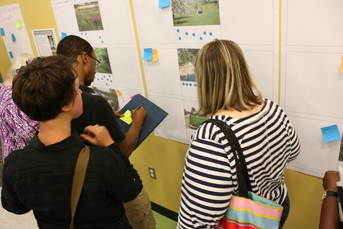|
In
addition to choosing among candidates on November 8, 2016, voters in Baltimore City
will be asked to make decisions on several bond issue and charter amendment
questions on the ballot.
Questions
A through D are bond issue questions, and are directly related to the capital
budget. Every two years, voters are asked to authorize the City to issue
general obligation (G.O.) bonds, which are debt instruments secured by the full
faith and credit of the City. The questions are sometimes referred to as loan
authorizations, as voters are authorizing the City to issue debt that will be
paid back over time. Each bond issue question refers to a “loan” dedicated to a
specific purpose, described further below.
This
year, voters are being asked to authorize up to $130 million over two years to fund
the City’s capital program. These long-term investments in physical
infrastructure will support residents, neighborhoods, and jobs in Baltimore by
helping to build affordable housing, improve schools, revitalize neighborhoods,
and improve public facilities.
Read
below and visit our website to learn more about each loan and see examples of
the types of projects each could fund. Don’t
forget to vote “FOR” these questions on November 8, 2016 to allow the City to
continue to invest in its future!
The
new Affordable Housing Loan would allow the City to spend up to $6 million over
two years to be used for an affordable housing program, including acquisition,
preservation, demolition, rental assistance, and housing counseling (among
other related activities). Learn more.
The Schools Loan would allow the City to invest up to $34 million
over two years in improving City school facilities. This loan complements the
much larger 21st Century Schools initiative by providing
funding for large-scale maintenance improvements along with a few new school
construction projects. Learn
more.
The Community and Economic Development Loan would provide the
City up to $45 million over two years to be used for community and economic
development. Potential uses range from renovation of some of the City’s
cultural institutions to acquisition and demolition of vacant homes, among
other activities. Learn more.
The Recreation and Parks and Public Facilities Loan would allow the City to invest up to $45 million over two years to improve public buildings and land, including libraries, parks, municipal buildings and other city-owned properties. Learn more.
For more information on the capital improvement program or the bond
issue questions that will appear on the ballot, contact Kristen Ahearn at (410)
396-8357 or Kristen.ahearn@baltimorecity.gov.

There are a number of activities planned and underway throughout
the fall to continue to engage community members and other stakeholders as part
of the Green Network Plan process. The Green Network Plan will set a bold vision for reimagining vacant and
abandoned properties and transforming them into community assets such as parks,
gardens, urban farms, open space and future development sites.
The completed plan will include three major elements:
·
A citywide Vision Plan for creating an interconnected network
of green spaces
·
Pilot area greening and development strategies for neighborhoods
in East, West, and Southwest Baltimore
·
Recommendations to support short-term implementation of
demonstration projects and long-term implementation of the citywide green
network.
The pilot area strategies will include recommendations for
demolition, permanent and temporary greening projects, and opportunities for
future redevelopment from which initial pilot project implementation
opportunities will be identified. The pilot areas are:
·
East – Broadway East & South Clifton Park
·
West – Sandtown-Winchester and Harlem Park
·
Southwest – Shipley Hill, Boyd-Booth, and Carrollton Ridge
For more information about upcoming focus area community
meetings in October and November, contact Kate Edwards at 410-396-5934 or kate.edwards@baltimorecity.gov.
To learn more about the Green Network Plan and find out about other upcoming
meetings, visit: http://planning.baltimorecity.gov/green-network-plan.
|